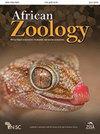乌干达东部维多利亚湖新月区以玉米为主的农业生态系统中有害啮齿动物的种群和繁殖模式:纳塔伦西斯Mastomys natalensis
IF 0.5
4区 生物学
Q4 ZOOLOGY
引用次数: 4
摘要
多乳鼠(Mastomys natalensis)是撒哈拉以南非洲谷物作物生产的主要啮齿动物。本研究旨在获取乌干达东部马尤格区玉米为主的农业生态系统中纳他棱线虫种群波动和繁殖模式的信息。该地区的特点是双峰降雨模式,3月至5月和8月至11月期间降雨。在耕地和休耕地栖息地进行了捕获-标记-再捕获研究,每个栖息地有两块60米乘60米的地块,有49个等距的捕获点。诱捕每月进行一次,连续三个晚上,研究从2016年1月延长到2018年6月。广义线性混合模型分析显示,与耕地相比,休耕地的人口密度估计值显著更高(β=0.69,p<0.0001),第一个雨季的密度估计值也显著更高,第一个旱季的密度估计数最低(β=0.75,p=0.006)。繁殖雌性的百分比在不同月份(χ2=27.05,df=11,p=0.003)和季节(χ2=17.64,p=0.0003)之间存在显著差异,但在3月至7月(即第一个雨季延伸至第二个旱季)的百分比明显较高,而在第一个旱季(即2017年1月和2月以及2018年2月)的百分比通常最低。这项研究的结果对控制工作的时间安排有重要影响,并建议在雨季之前的旱季开始控制,以抵消在预计种植作物的雨季后期潜在的破坏性种群积累。本文章由计算机程序翻译,如有差异,请以英文原文为准。
Population and Breeding Patterns of the Pest Rodent: Mastomys natalensis in a Maize Dominated Agroecosystem in Lake Victoria Crescent Zone, Eastern Uganda
Multimammate mice (Mastomys natalensis) are a key rodent pest species to cereal crop production in Sub-Saharan Africa. This study aimed at generating information on the population fluctuation and breeding patterns of M. natalensis in a maize dominated agro-ecosystem in the Mayuge district, Eastern Uganda. The area is characterised by a bimodal rainfall pattern with rains in the periods March to May and August to November. A Capture–Mark–Recapture study was established in cultivated and fallow field habitats with, in each habitat, two plots of 60 m by 60 m with 49 evenly spaced trapping points. Trapping was conducted monthly for three consecutive nights, and the study extended from January 2016 to June 2018. A Generalised Linear Mixed Model analysis showed significantly higher population density estimates (β = 0.69, p < 0.0001) in fallow land compared to cultivated fields, and also significantly higher density estimates(β = 0.75, p = 0.006) in the first wet season and lowest in the first dry season. The percentage breeding females differed significantly across months (χ2 = 27.05, df = 11, p = 0.003) and seasons (χ2 = 17.64, p = 0.0003). Breeding females occurred throughout all the months of trapping, but with significantly higher percentages in the months of March to July (i.e. first wet season extending to second dry season) and generally lowest in the first dry months (i.e. January and February in 2017, and February 2018). The results of this study have important consequences for the timing of control efforts, and recommends that control should be initiated during the dry seasons prior to wet seasons to counteract potential damaging population build up in later wet seasons when crop planting is expected.
求助全文
通过发布文献求助,成功后即可免费获取论文全文。
去求助
来源期刊

African Zoology
生物-动物学
CiteScore
2.60
自引率
9.10%
发文量
18
审稿时长
>12 weeks
期刊介绍:
African Zoology , a peer-reviewed research journal, publishes original scientific contributions and critical reviews that focus principally on African fauna in terrestrial, freshwater, and marine ecosystems. Research from other regions that advances practical and theoretical aspects of zoology will be considered. Rigorous question-driven research in all aspects of zoology will take precedence over descriptive research. The Journal publishes full-length papers, critical reviews, short communications, letters to the editors as well as book reviews. Contributions based on purely observational, descriptive or anecdotal data will not be considered.
The Journal is produced by NISC in association with the Zoological Society of South Africa (ZSSA). Acceptance of papers is the responsibility of the Editors-in-Chief in consultation with the Editors and members of the Editorial Advisory Board. All views expressed are those of the author and not necessarily those of the Editors or the Department.
 求助内容:
求助内容: 应助结果提醒方式:
应助结果提醒方式:


